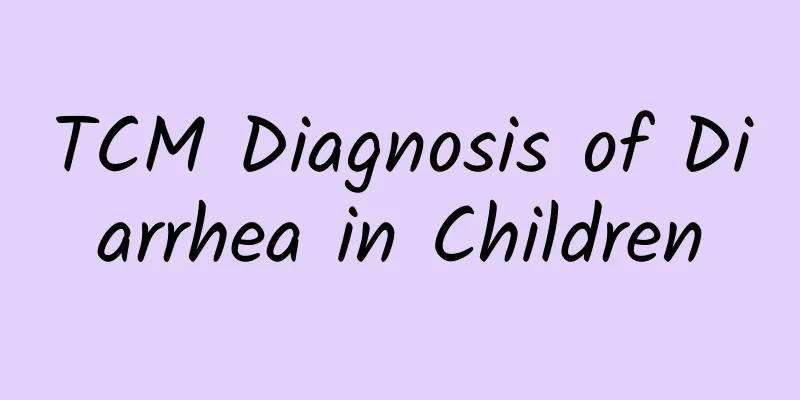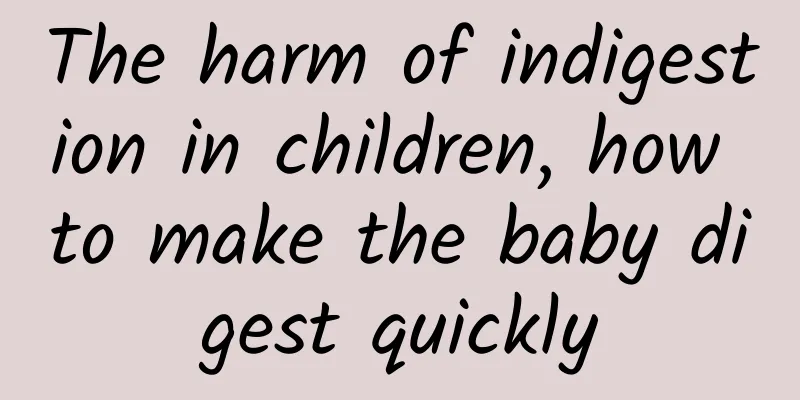TCM Diagnosis of Diarrhea in Children

|
With the arrival of summer, all kinds of cold foods are available. For children, there is one more delicious food. Summer is also a season when bacteria are easy to breed, which can easily cause diarrhea in children. Summer diarrhea in children is determined by the physiological characteristics of children. Children's diarrhea may also be accompanied by symptoms such as vomiting, abdominal distension, and poor spirits. If you find that your baby has diarrhea, early diagnosis and early treatment are recommended. The following is the diagnosis of children's diarrhea: Diagnosis of diarrhea in children The clinical diagnosis is made based on the onset season, medical history (including feeding history and epidemiological data), clinical manifestations and stool characteristics, combined with routine stool examination, bacterial culture, complement fixation test, enzyme-linked immunosorbent assay and electron microscopy. Dehydration, acidosis and electrolyte imbalance must be determined. Clinical diagnosis can be easily made based on medical history, physical examination and stool characteristics. According to the duration of diarrhea and the severity of symptoms, the stage and type of diarrhea can be determined; the presence of dehydration and the degree and nature of dehydration, acidosis and electrolyte imbalance can be determined, and the cause of the disease can be sought, such as improper feeding, internal and external intestinal infection, etc. (I) Diagnostic basis 1. Changes in stool characteristics, such as loose stools, watery stools, mucous stools, or bloody stools. 2. More frequent bowel movements than usual. (II) According to the course of the disease, it is divided into 1. Acute diarrhea - the course of the disease is within 2 weeks. 2. Protracted diarrhea - the course of the disease is between 2 weeks and 2 months. 3. Chronic diarrhea - the course of the disease is more than 2 months. (III) According to the condition, it is divided into 1. Mild, no dehydration, no poisoning symptoms. 2. Medium, mild to moderate dehydration or mild poisoning symptoms. 3. Severe, severe dehydration or obvious poisoning symptoms. (IV) Etiological diagnosis 1. Infectious diarrhea: 1) For acute enteritis, the most likely pathogen can be estimated based on stool characteristics, stool microscopy, epidemic season and age of onset, which can be used as a reference for medication. Watery stools in epidemic diarrhea are mostly caused by rotavirus or toxigenic bacteria, especially in infants under 2 years old. If it occurs in autumn and winter, rotavirus enteritis is more likely; if it occurs in summer, ETEC enteritis is more likely. If the stool is mucus or purulent, invasive bacterial infection should be considered, such as EIEC enteritis, Campylobacter jejuni enteritis or Salmonella enteritis. 2) Units with conditions should conduct etiological examinations such as bacteria, viruses and parasites. Stool bacterial culture can be performed for patients with more white blood cells in stool microscopy; patients suspected of viral enteritis can obtain stool filtrate or centrifugation supernatant in the acute phase (within 3 days of onset) and stain them with electron microscopy or immunoelectron microscopy; immunological methods (such as ELISA, solid phase radioimmunoassay, etc.) can also be used to detect viral antigens in stool and specific antibodies in serum. Viral RNA gel electrophoresis can directly extract RNA from feces, and rotavirus electrophoresis typing can be performed according to the characteristic RNA spectrum, which is divided into long and short types. Although serological examinations of patients with intestinal infections caused by various pathogens are not very helpful in clinical practice, they are quite meaningful for epidemiological surveys and retrospective diagnosis. After the pathogen is identified, it can be diagnosed according to etiology, such as pathogenic Escherichia coli enteritis, Campylobacter jejuni enteritis, rotavirus enteritis, etc. 2. Non-infectious diarrhea: Based on medical history, symptoms and examination analysis, it can be diagnosed as bait diarrhea, symptomatic diarrhea, allergic diarrhea, etc. (V) Assessment of dehydration: The degree and nature of dehydration, electrolyte imbalance and acidosis are determined based on clinical manifestations, blood electrolytes and carbon dioxide binding capacity measurements. The above is about the diagnosis of pediatric diarrhea. Children with severe diarrhea should be sent to the hospital for treatment as soon as possible to prevent the condition from getting worse and threatening your child's health or even life. Because the baby is still young and the gastrointestinal tract is not yet fully developed, parents must feed the baby scientifically and rationally, and give the baby less cold drinks. |
<<: Early diagnosis of diarrhea in children
>>: Diagnosis and treatment guidelines for pediatric diarrhea
Recommend
Can acute laryngitis in children be completely cured?
When children suffer from acute laryngitis, they ...
What to do if the neonatal jaundice value is 22
What should I do if the newborn's jaundice va...
Daily care of acute laryngitis in children
In daily care for children with acute laryngitis,...
Best time to treat ADHD
The best time to treat ADHD is between the ages o...
Research has found that electric mosquito coils are liver toxic? So can electric mosquito coils still be used? This article will tell you
On summer nights, the breeze brings coolness, but...
The best treatment for hand, foot and mouth disease
There is generally no best treatment for hand, fo...
What should I do if my five-month-old baby has a cough? What are the methods to relieve the cough of a five-month-old baby?
If a five-month-old baby has a little cough, it m...
What to eat for children with kidney disease? Six kinds of food are recommended for children with kidney disease
Nephrotic syndrome is a well-known difficult-to-c...
What are the traditional Chinese medicine treatments for patent ductus arteriosus?
What is the TCM treatment method for patent ductu...
How to treat chronic cough in babies
Many babies suffer from chronic cough, which can ...
How many days does it take for a baby to recover from hand, foot and mouth disease? What is the correct way to care for a baby with hand, foot and mouth disease?
How many days does it usually take for a baby to ...
What food to eat to treat acute laryngitis in children
Spring and autumn are the peak seasons for the re...
How old is the hand, foot and mouth disease vaccine? How many shots are needed?
Hand, foot and mouth disease vaccine is an import...
Misunderstandings in the Treatment of Pediatric Eczema
When children have eczema, we are all very anxiou...
How to scientifically judge a child's fever? Key points for medication for children's colds and fevers
Cold is a common disease in children. Generally, ...









